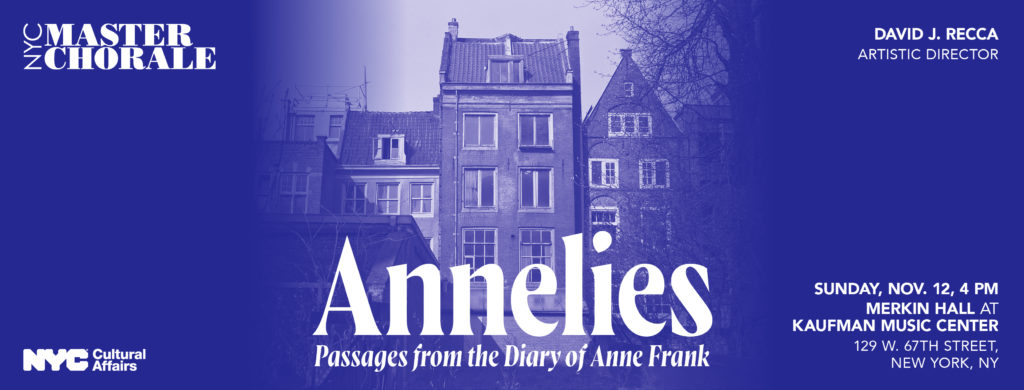
A Message from the Board
A primary goal of the New York City Master Chorale is to represent and draw inspiration from the diversity of our city. What makes New York vibrant—dynamic at times and wonderfully mundane at others—is that it is ultimately made up of individuals. Each person’s story is both ordinary and extraordinary. It is both the remarkable and the day-to-day that make our personal narratives so powerful, giving personal context and color to abstract ideas and historic moments.
This idea of the personal and the global is one we have explored in the preparation of Annelies. This challenging and rewarding work is not one to inhabit a few hours a week and unthinkingly abandon until the next Wednesday. It has required us to take the founding educational aspects of our mission and to turn them inward, devoting time in and between rehearsals to think deeply. Over the past ten weeks, we have held group discussions, participated in a docent-guided tour at the Museum of Jewish Heritage, and learned from Rachael Cerrotti, an educator, author, and storyteller who has spent over a decade retracing and sharing her grandmother Hana Dubova’s Holocaust survival journey. These steps have been crucial to our understanding of the story we are sharing with you tonight. They have helped us find comfort and connection in sharing these words, which for some of us are deeply personal and which for all of us have the power to stir deep, complicated emotions.
Engaging with Annelies has required us to consider the intersections of personal stories and the history of whole peoples, places, and times, as well as why and how particular ones are remembered more prominently than others. Our individual and collective learning does not end with this performance, and we are eager to continue to incorporate such dramaturgical and scholarly resources in our future programs, building on our commitment to make each piece not only pitches and rhythms but also peoples and narratives – an escape and an entry point for greater understanding.
Oppression is ongoing and intersectional, but so is justice. We hope you will join us in embracing the responsibility we have to learn, to advocate for each other, and to care. To begin, we invite you to explore some of the resources we have used in preparing this piece:
- Sounds Choral on WWFM – Composer James Whitbourn and James Jordan, Westminster Choir College professor and director of the Westminster Conducting Institute discussing Annelies
- Sounds Choral on WWFM – Composer James Whitbourn and James Jordan, Westminster Choir College professor and director of the Westminster Conducting Institute discussing Annelies
-
- Established in 1957, the Anne Frank House preserves the building where Anne, her family, and others hid and provides educational programming, exhibitions, and publications to the public, working to both share the history of the people and place and inspire visitors to look to the future. Otto Frank, Anne’s father and the only member of the family to survive the Holocaust, drove both the publication of her diary and the establishment of the museum, with which he was closely involved until his passing in 1980. The House offers a wealth of resources online, including those mentioned below, and receives over a million in-person visitors annually.
- Established in 1957, the Anne Frank House preserves the building where Anne, her family, and others hid and provides educational programming, exhibitions, and publications to the public, working to both share the history of the people and place and inspire visitors to look to the future. Otto Frank, Anne’s father and the only member of the family to survive the Holocaust, drove both the publication of her diary and the establishment of the museum, with which he was closely involved until his passing in 1980. The House offers a wealth of resources online, including those mentioned below, and receives over a million in-person visitors annually.
-
- In mid-September, NYCMC hosted photographer, writer, educator and producer Rachael Cerrotti, who spoke with us about the use of first-hand source material in storytelling and shared her grandmother Hana’s Holocaust survival story, some of which was compiled from Hana’s own diaries. Rachael has shared Hana’s story as a podcast, museum exhibit, and book, publishing We Share The Same Sky: A Memoir of Memory & Migration in 2021.
- In mid-October, members of our choir visited The Museum of Jewish Heritage and participated in a guided tour of their permanent exhibit The Holocaust: What Hate Can Do. For educators, the museum also has a free curriculum guide for the Diary of Young Girl available on their website.
- Whitbourn’s chamber instrumentation (violin, clarinet, cello, and piano) echoes the instrumentation of a highly influential piece, Quartet for the End of Time by Olivier Messiaen. Written while Messiaen was in a German prisoner of war camp, the piece has a remarkable history. Read more: Carnegie Hall: Five Things to Know about the Quartet for the End of Time.
- In mid-September, NYCMC hosted photographer, writer, educator and producer Rachael Cerrotti, who spoke with us about the use of first-hand source material in storytelling and shared her grandmother Hana’s Holocaust survival story, some of which was compiled from Hana’s own diaries. Rachael has shared Hana’s story as a podcast, museum exhibit, and book, publishing We Share The Same Sky: A Memoir of Memory & Migration in 2021.

